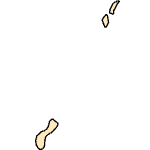Cambarus cumberlandensis
(Cumberland crayfish)
Crustaceans-Crayfish
Native Transplant |
|
Common name: Cumberland crayfish
Taxonomy: available through
www.itis.gov
Identification: Cambarus cumberlandensis has been described by Hobbs and Bouchard (1973) and Taylor and Schuster (2004) as being uniform in color but ranging from blue-green, green, greenish brown, to brown. The juveniles can also be uniform in color but sometimes are mottled. This species has a dorsal dark brown band anterior to the cephalon (head). The spines and tubercles on the carapace range in color from orange, yellow, to cream. Both fingers on the chelae (pincers) are a fading yellow coloration. The ventral surface is cream to white color. The rostrum has marginal spines highlighted in cream to gold.
Size: Maximum size 112.5 mm in total length (Taylor and Schuster 2004).
Native Range: Cambarus cumberlandensis is native to the Cumberland Plateau, and occurs in the upper Cumberland River and its tributaries in Kentucky downstream to the Roaring Fork River in Jackson County, Tennessee (Hobbs and Bouchard 1973; Taylor and Schuster 2004). It is also native to sites in the Little Barren River and Russell Creek of the Green River drainage, Kentucky (Taylor and Schuster 2004).



|

Alaska |

Hawaii |

Puerto Rico &
Virgin Islands |

Guam Saipan |
Hydrologic Unit Codes (HUCs) Explained
Interactive maps: Point Distribution Maps
Nonindigenous Occurrences:
Table 1. States with nonindigenous occurrences, the earliest and latest observations in each state, and the tally and names of HUCs with observations†. Names and dates are hyperlinked to their relevant specimen records. The list of references for all nonindigenous occurrences of Cambarus cumberlandensis are found here.
Table last updated 11/26/2024
† Populations may not be currently present.
Ecology: This species lives in medium to large creeks and rivers, where is most commonly found in swift-flowing waters under debris, large cobble, or slab boulders. Larger adults are usually found in the thalweg (middle) of the stream (Hobbs and Bouchard 1973; Taylor and Schuster 2004). Cambarus cumberlandensis is often found with crayfish species from the genus Faxonius (Orconectes) (Taylor and Schuster 2004).
Means of Introduction: Possible bait bucket introduction.
Status: Established in Tennessee.
Impact of Introduction: The impacts of this species are currently unknown, as no studies have been done to determine how it has affected ecosystems in the invaded range. The absence of data does not equate to lack of effects. It does, however, mean that research is required to evaluate effects before conclusions can be made.
References: (click for full references)
Hobbs, H. H., Jr. and R. W. Bouchard. 1973. A new crayfish from the Cumberland River system with notes on Cambarus carolinus (Erichson). Proceedings of the Biological Society of Washington 86(5):41-68.
Hobbs, H.H., Jr. 1989. An illustrated checklist of the American crayfishes (Decapoda: Astacidae, Cambaridae, and Parastacidae). Smithsonian Contributions to Zoology 480:1-236.
Taylor, C.A., and G.A. Schuster. 2004. The crayfishes of Kentucky. Illinois Natural History Survey, Champaign, IL.
Author:
Daniel, W.M.
Revision Date: 3/20/2019
Peer Review Date: 3/20/2019
Citation Information:
Daniel, W.M., 2024, Cambarus cumberlandensis Hobbs and R.W. Bouchard, 1973: U.S. Geological Survey, Nonindigenous Aquatic Species Database, Gainesville, FL, https://nas.er.usgs.gov/queries/FactSheet.aspx?SpeciesID=205, Revision Date: 3/20/2019, Peer Review Date: 3/20/2019, Access Date: 11/26/2024
This information is preliminary or provisional and is subject to revision. It is being provided to meet the need for timely best science. The information has not received final approval by the U.S. Geological Survey (USGS) and is provided on the condition that neither the USGS nor the U.S. Government shall be held liable for any damages resulting from the authorized or unauthorized use of the information.